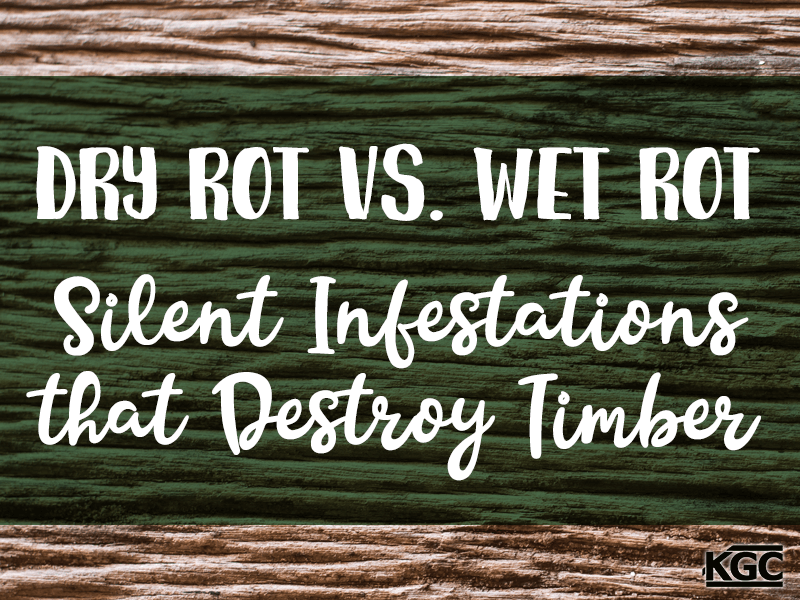Do you know the one mistake that so many homeowners make? Ignoring the first signs of water damage on wood and timber in their homes.
Left untreated, water damage can end up costing you far more than simply fixing a leak or faulty gutter. What looks like minor damage that you’d be tempted to ignore can quickly become a large-scale wet or dry rot issue and end up costing you thousands.
When too much water infiltrates timber, this provides a fertile ground for fungus to germinate and grow. Most homeowners will at some stage likely encounter dry rot or wet rot: it could be small-scale damage to a garden fence, or it could be more significant damage to windows, doors, or structural timbers in roof or walls.
Dry rot and wet rot are both forms of fungal decay that attacks wood. The dampness and conditions determine which kind of fungus develops, and how they grow and spread.
Excess moisture can come from rising damp from the ground, external penetration through leaks or cracks in the wall or roof, or internal moisture from trapped condensation.
Once established, they spread quickly to destroy even more timber nearby and cause even more damage, so taking action early is important.
Dry rot and wet rot are different fungi, so they require different kinds of treatment.
Dry Rot
Dry rot can cause very serious problems to homes. Dry rot comes from a fungus called Serpula lacrymann, also called brown rot.
It often grows in dark, humid areas and you might not notice it for a long time. Conditions in Oregon are ideal for dry rot to develop.
Dry rot attacks the cellulose in the wood, drawing moisture from the wood, which turns dark brown and becomes brittle.
As it grows, it searches out more wood that it can infect, even if the wood is dry and doesn’t have excess moisture. At this stage, it can simply colonize healthy wood and grow more than a meter every few months.
It’s not as common at wet rot, but it is more serious. Dry rot can grow on wood that has become wet, usually with more than 20% moisture content.
What to look for
Keep an eye out for:
- Shrinking or cracked wood that’s dark or with cube-like cracks
- White or grey fluffy cotton-like growth (mycelium) with ‘teardrops’ (where the fungus gets its name from) on it
- Orange or deep red fruiting bodies with big rust-red pores around them
- Wood strands that are brittle and dry, and crumple in your hands
- A moldy, damp, musty smell
Wet rot
Wet rot is more common and less serious than dry rot. Wet rot can be caused by several different types of fungus such as Coniophora puteana or Poria vaillantii, unlike dry rot which only comes from Serpula lacrymann.
Wet rot doesn’t spread to healthy dry wood and only affects wood or timber that has been wet for a long time and has 30-60% moisture content levels. Typically, this will happen when there are plumbing, guttering, roof, pipe leaks or even a leaking washing machine that keep the timber wet consistently.
Any damp and humid condition with poor ventilation increases the chances of getting wood rot. The excess water is the perfect breeding ground for the fungus to grow, feeding on the wood and destroying it bit by bit.
What to look for
Keep an eye out for:
- Localized fungus on wet timber or wood
- Spongy and soft timber (rather than crumbly like dry rot)
- Wood that looks darker than other wood nearby
- A bleached appearance to wood
- Flaky or damaged paint with soft wood behind it
- A musty, damp, moldy smell
- Wood surrounding an obvious leak
What to do about dry rot and wet rot
If you have wet rot, the easiest thing is to find and eliminate the source of moisture, and then remove and replace the water damaged timber. That should take care of the wet rot issue. If you’re replacing timber, make sure it’s treated to protect from future infestation in case of moisture.
Dry rot may require a more intense chemical treatment to remove the infestation, because it may have spread beyond the damaged wet timber and attacked the dry, healthy one. A professional will try to expose all the infested wood and find out the extent of the infestation.
The source of the moisture still needs to be found and dried out, the area cleaned, and all timber surrounding the dry rot area treated.
Call a pro
It can be hard to spot wet rot or dry rot before the infestation is well established, because frequently the initial growth is hidden behind wall paneling or deep in lintel cracks or joist ends.
It’s not an exact science identifying the type of rot you have, as it can affect timber in different ways: best to deal with leaks and excess moisture immediately, and call in a trained pro if you think you have wet rot or dry rot issue.
If you have a leak or suspect water damage, give us a call—we’re here to help.

